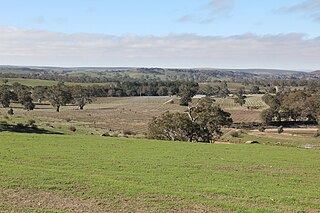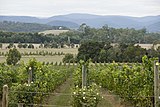
Seymour is a town located in the Southern end of the Goulburn Valley in the Shire of Mitchell, Victoria, Australia and is located 104 kilometres (65 mi) north of Melbourne. At the 2021 census, Seymour had a population of 6,569. The township services the surrounding agricultural industries as well as the nearby military base of Puckapunyal, which is an important training centre for the Australian Army. Other important sectors of employment in Seymour include retail, light engineering, agricultural services support, medical services, and education.

The Central Otago wine region is a geographical indication in New Zealand's South Island, and the world's southernmost commercial wine growing region. While Central Otago is best known for Pinot Noir, many white wine varieties are also popular.

The Goulburn Valley is a sub-region, part of the Hume region of the Australian state of Victoria. The sub-region consists of those areas in the catchment of the Goulburn River and other nearby streams, and is part of the Murray-Darling Basin. The Goulburn Valley is bordered on the south by the Great Dividing Range and to the north by the Murray River, the state border with New South Wales. The sub-region is one of Australia's most productive and intensively farmed areas and is predominantly irrigated.

Nagambie is a town in the Goulburn Valley region of Victoria, Australia. The city is on the Goulburn Valley Freeway north of Seymour and in the Shire of Strathbogie. As of 2021 census, Nagambie had a population of 2,254.

The Australian wine industry is one of the world's largest exporters of wine, with approximately 800 million out of the 1.2 to 1.3 billion litres produced annually exported to overseas markets. The wine industry is a significant contributor to the Australian economy through production, employment, export, and tourism.

New Zealand wine is produced in several of its distinct winegrowing regions. As an island country in the South Pacific Ocean, New Zealand has a largely maritime climate, although its elongated geography produces considerable regional variation from north to south. Like many other New World wines, New Zealand wine is usually produced and labelled as single varietal wines, or if blended, winemakers list the varietal components on the label. New Zealand is best known for its Marlborough Sauvignon Blanc, and more recently its dense, concentrated Pinot Noir from Marlborough, Martinborough and Central Otago.
Tahbilk Winery is a historic Australian winery with National Trust certification. It is located 120 km (75 mi) north of Melbourne between the townships of Seymour and Nagambie in the Nagambie Lakes a sub region of Goulburn Valley Wine Region. It was established in 1860, and is the oldest family-owned winery and vineyard in Victoria. The winery is part of Australia's First Families of Wine, a prominent Australian wine alliance.

The South Australian wine industry is responsible for more than half the production of all Australian wine. South Australia has a vast diversity in geography and climate which allows the state to be able to produce a range of grape varieties–from the cool climate Riesling variety in the Clare Valley wine region to the big, full bodied Shiraz wines of the Barossa Valley.

Victorian wine is wine made in the Australian state of Victoria. With over 600 wineries, Victoria has more wine producers than any other Australian wine-producing state but ranks third in overall wine production due to the lack of a mass bulk wine-producing area like South Australia's Riverland and New South Wales's Riverina. Viticulture has existed in Victoria since the 19th century and experienced a high point in the 1890s when the region produced more than half of all wine produced in Australia. The phylloxera epidemic that soon followed took a hard toll on the Victoria wine industry which did not fully recover till the 1950s.
Australia's First Families of Wine (AFFW) is an Australian wine initiative to raise the profile of Australian wine to the world, showcasing a representative of its landmark wines and to highlight the quality and diversity of Australian wine. Established by a collective of twelve multi-generational family-owned wine producers. Together the families represent seventeen wine-growing regions across Australia and forty-eight generations of winemakers. It was officially launched at the Sydney Opera House on 31 August 2009 by Tony Burke, Minister for Agriculture, Fisheries and Forestry.

The Hunter Valley is one of Australia's wine regions. Located in the state of New South Wales and first cultivated in the early 19th century, it was one of the first Australian wine regions. As well as Hunter Valley Sémillon, the region produces wine from a variety of grapes including Shiraz, Chardonnay, Cabernet Sauvignon and Verdelho.

Eden Valley wine region is a wine region located in South Australia immediately north of the capital city of Adelaide which covers an area in the Mount Lofty Ranges extending from Truro in the north to just south of Springton in the south. The region received appellation as an Australian Geographical Indication in 1997 and as of 2014, it is represented by at least 36 wineries.

Mount Lofty Ranges zone is a wine zone located in South Australia west of the Murray River that occupies the Adelaide metropolitan area north of Glenelg, extending as far north as Crystal Brook, and as far south as Mount Compass in the Mount Lofty Ranges. The zone which encloses the Barossa zone on three sides, includes three wine regions that have received appellation as Australian Geographical Indications (AGIs): Adelaide Hills, Adelaide Plains and Clare Valley. The zone received AGI in 1996.
Mudgee is a wine region and Australian Geographical Indication in the Central Ranges zone in the Australian state of New South Wales. It is named for the town of Mudgee.

Orange is a wine region and Australian Geographical Indication in the Central Ranges zone in the Australian state of New South Wales. It is named for the town of Orange and defined as the contiguous area that is above 600 metres (2,000 ft) elevation within the City of Orange, Cabonne Shire and Blayney Shire.

The Hawke's Bay wine region is New Zealand's oldest and second-largest wine-production region, on the east coast of the North Island. Production reached 41,000 tonnes in 2018 from 4,681 hectares of planted vines, representing 10.2% of total national production. Some of the oldest wineries still operating in New Zealand, including Te Mata Estate, Church Road, and Mission Estate, were established in the Hawke's Bay area in the late 19th century. Despite this, it was only established as a geographical indication (GI) in 2018. The GI protects any wine produced within the boundaries of the entire Hawke's Bay Region, but in practice the vineyards are chiefly concentrated in the plains and low hills surrounding the cities of Napier and Hastings.
Tabilk is a locality located in the Shire of Strathbogie. The 2016 census recorded that 131 people lived in the area. The closest major towns are Nagambie, Avenel and Seymour (About 25–30 minutes south-west of Tabilk.
Nagambie Lakes is a subregion of the Goulburn Valley wine region in the Australian state of Victoria. Lake Nagambie on the Goulburn River is the largest waterbody in the region, and Nagambie is the main town.
Upper Goulburn is a wine region in the Australian state of Victoria. It was designated as an Australian Geographical Indication on 14 October 2003. It is located north of the Yarra Valley wine region on slopes that drain to the north and west into the Goulburn River and eventually the Murray River. To its north are the wine regions of Goulburn Valley, Strathbogie Ranges and King Valley.














